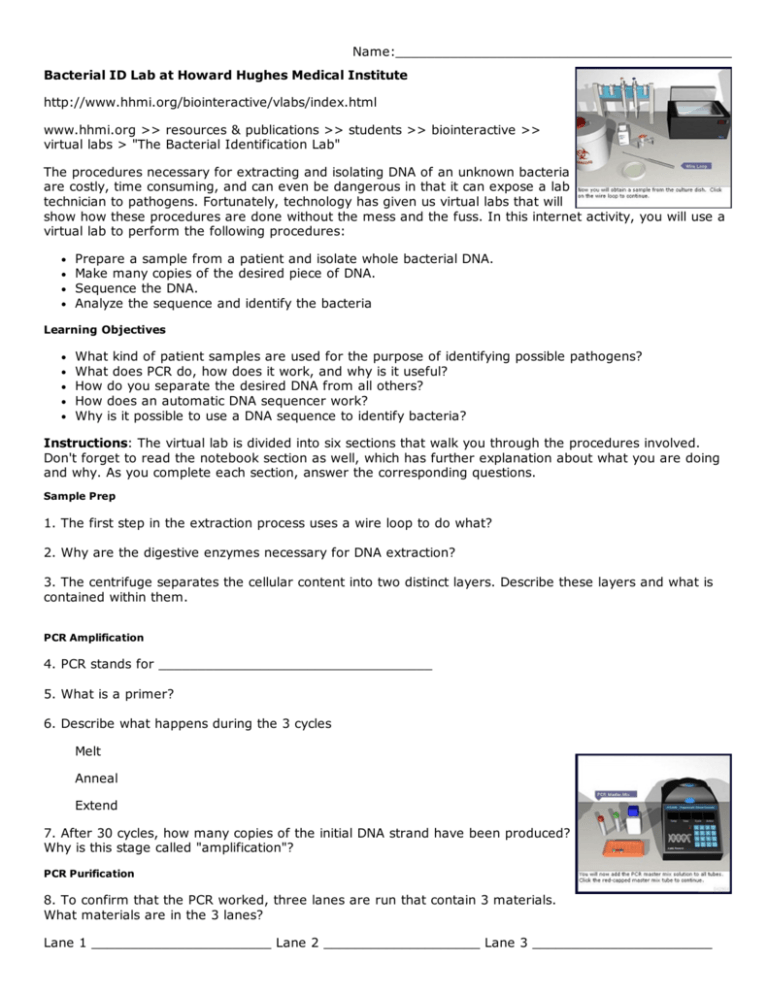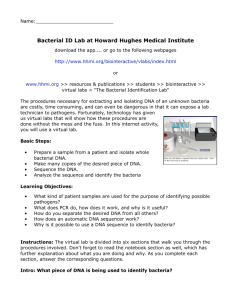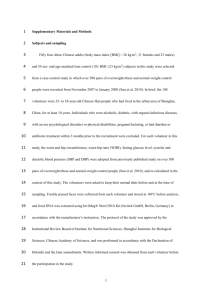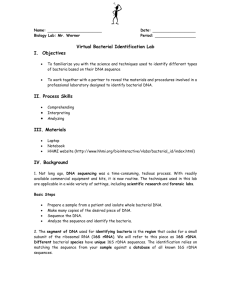Bacterial ID Virtual Lab Worksheet
advertisement

Name:___________________________________________ Bacterial ID Lab at Howard Hughes Medical Institute http://www.hhmi.org/biointeractive/vlabs/index.html www.hhmi.org >> resources & publications >> students >> biointeractive >> virtual labs > "The Bacterial Identification Lab" The procedures necessary for extracting and isolating DNA of an unknown bacteria are costly, time consuming, and can even be dangerous in that it can expose a lab technician to pathogens. Fortunately, technology has given us virtual labs that will show how these procedures are done without the mess and the fuss. In this internet activity, you will use a virtual lab to perform the following procedures: Prepare a sample from a patient and isolate whole bacterial DNA. Make many copies of the desired piece of DNA. Sequence the DNA. Analyze the sequence and identify the bacteria Learning Objectives What kind of patient samples are used for the purpose of identifying possible pathogens? What does PCR do, how does it work, and why is it useful? How do you separate the desired DNA from all others? How does an automatic DNA sequencer work? Why is it possible to use a DNA sequence to identify bacteria? Instructions: The virtual lab is divided into six sections that walk you through the procedures involved. Don't forget to read the notebook section as well, which has further explanation about what you are doing and why. As you complete each section, answer the corresponding questions. Sample Prep 1. The first step in the extraction process uses a wire loop to do what? 2. Why are the digestive enzymes necessary for DNA extraction? 3. The centrifuge separates the cellular content into two distinct layers. Describe these layers and what is contained within them. PCR Amplification 4. PCR stands for ___________________________________ 5. What is a primer? 6. Describe what happens during the 3 cycles Melt Anneal Extend 7. After 30 cycles, how many copies of the initial DNA strand have been produced? Why is this stage called "amplification"? PCR Purification 8. To confirm that the PCR worked, three lanes are run that contain 3 materials. What materials are in the 3 lanes? Lane 1 _______________________ Lane 2 ____________________ Lane 3 _______________________ 9. What is the overall purpose of the purification stage? Sequencing Prep 10. Describe the “sequencing brew” that you added your purified PCR to. 11. The purpose of the second PCR is not to create identical copies like the first PCR you ran. What is the purpose of this PCR? DNA Sequencing 12. What is the final PCR product, the stuff contained in your 12 tubes? 13. What is gel electrophoresis? Sequence Analysis 14. What is BLAST? 15. What is the identity of the bacteria in your sample? Follow the steps listed on the page and be patient. BLAST data can take a while to search. Extension and Formative Assessment **Look at the learning objectives at the beginning of this sheet. Did you accomplish these objectives? Redo the simulation to reinforce the steps involved. Write a short essay that discusses the learning objectives in this lab to show that you have accomplished them.**









